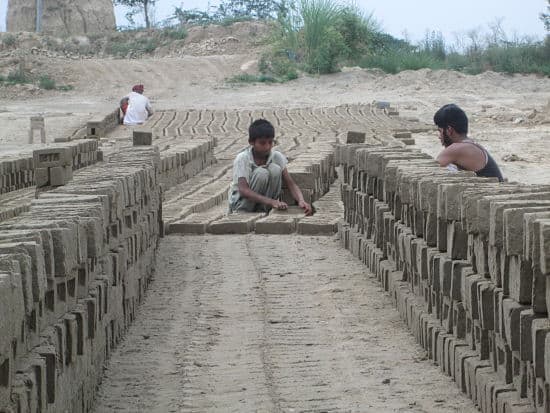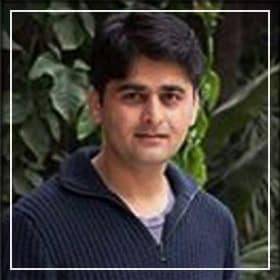The most common pattern for bonded labour in Pakistan is for a landlord or an employer to extend a loan to labourers, in advance of the work done, on the understanding that this advance payment or peshgi would be paid back by providing labour. Although in theory the loan is repayable over a period of time, in practice borrowers often cannot pay it back, despite their efforts, and become trapped in a vicious cycle of debt and forced labour. Landlords or employers exercise exclusive rights over the labour power of those who are indebted to them. They restrict labourers from taking up extra work elsewhere and control or manipulate other spheres of their lives as well. For example, if a family of bonded labourers at brick kiln has to visit relatives in a different town for a wedding, they may be required to leave behind at least one adult member at the kiln as a guarantee that the family would return to resume work. In extreme cases a landlord will decide on his workers’ marriages, the education (or not) of their children, and will exert the kind of control that a master had over his slave but with the added advantage of not having to make the initial investment of purchasing an individual.
Typically entire families of bonded labourers in agriculture, brick making and fishing work for the same landlord or employer. In brick kilns, for example, once a member of a family of bonded labourers has worked as a kiln labourer, he or she cannot work elsewhere at his or her own discretion while the debt remains outstanding. In some cases, family debt is transferred from one generation to the next even if the main earner has died or suffered permanent disability due to the hazardous nature of the work. Children have been documented to be working as main earners to pay off the debt for their dead or incapacitated elders. Landlords, their male family members, and foremen have been reported to sexually molest women bonded labourers who often do not speak out against such atrocities, due to their vulnerability to further violence whereas men in their families keep their silence or feign ignorance due to fear of violence.

Bonded labour is clearly no different than slavery.
The control exercised over men, women, and children of bonded labourers amounts to ‘ownership rights’ for the landlord or employer. In the case of agriculture, and to an extent brick making, the control exerted by the ‘employer’ is significantly increased because workers and their families often live ‘on site’ and are therefore not only constantly vulnerable to abuse but also face the threat of eviction, leading to a loss of living space. In recent past, many landowning castes have ventured into setting up industries and have taken with them their client castes to work for them in factories, especially in brick kilns and tanneries. Despite the new ‘contractual’ nature of bondage in these industries, the influence of traditional hierarchies and caste privileges remains strong. In other words,
even though the relations between the employers and employees are premised on capitalist methods of labour management (so as to achieve the control of labour and compression of costs), the vertical ties of subordination are rooted in the consciousness of both the employers and the workers as historically given and socially acceptable.
Some of the most horrific abuses of labourer’s human rights take place at the mining sites. Use of physical violence, incarceration in private ‘jails’ and the tracking down of those who are non-compliant have been reported for miners in various parts of the country. They usually live in shabby quarters at the mining sites hundreds of miles away from their native villages. The middlemen or recruiters, who have worked their way up to become sub-contractors, recruit workers from their own villages and adjoining areas by extending peshgi and thus binding them to work at mines located away from major towns. The fact that the labourers cannot escape the middleman because he is a co-villager or even a kinsman, coupled with being at a long distance from home, keeps the workers at the mines. The mines often lack necessary safety equipment and the labourers are forced to work in extremely hazardous conditions with no insurance. Occupational hazards further lead to a heavy burden of disease, which in turn often leads to workers taking out additional advances to treat the very illnesses that arise from the work that they undertake, thus creating a vicious cycle of debt-bondage. Tactics such as falsifying accounts, delaying wage payments, demanding rapid repayment and withholding or reducing periodic advances are used across all sectors to strengthen the grip of the employer and his men over bonded labourers. Violence or the threat of violence towards the individual worker and their families with verbal and physical abuse are also used to extract work from ‘lazy’ labourers and to prevent any attempts to escape. Even if a labourer does not directly experience physical abuse from his employer, the possibility of violence is part of his consciousness due to widely circulated stories about punishments meted out to defaulters and renegades.

The women labourers in agriculture are exploited not only by the employers but also by their husbands who demand productive and reproductive labour from them. The notion of ‘honour’, in this patriarchal social system, attached to the protection or violation of the female body. It turns their bodies, at once, into sites of vigilance and control and targets of abuse. Landlords have been reported to sexually assault women in order to shame entire families into submission and to continue the bondage. The threat or actual use of sexual violence or other forms of violence against women is an effective tool in their hands to keep bonded labourers under their control. In addition to the everyday physical violence that women have to endure or the threat of which that looms large, there is the structural violence of patriarchy which remains invisible, often internalized as a cultural value and unchallenged at multiple levels.
Bonded labour enjoys a degree of cultural acceptance at broader level in Pakistani society.
There have been accounts of judges in the higher judiciary reprimanding labourers for not honouring their debts. Some academics condone the system of patron-clientism, which forms an important basis of bonded labour in agriculture, as fundamental to Pakistani society. The workers in debt-bondage are seen to have ‘chosen’ to sacrifice their freedom for the security and other benefits that come with patronage—e.g. access to loans, to the police, courts, schools, and hospitals. The implication is that this relationship is mutually beneficial for the landlord and the worker. Another common perspective on bonded labour is what has been termed by some economists as the ‘double coincidence of wants’. According to this a system of advance payments is a mutually advantageous contract between the employer and the worker as it provides a degree of predictability and regularity to both parties by ensuring a stable supply of a disciplined labour force to the employer and regular employment for the labourers. In a context of high unemployment and precariousness it is, thus, the security of employment that the labourers willingly trade for their freedom and the employers risk their capital in order to ensure future supply of labour. Therefore, it would make perfect sense for not only the employer to keep mounting the debt on the labourers but also the labourer to avoid clearing it completely. The peshgi, therefore, is a way of tying not only the labourer to the employer but also vice versa. Therefore, the labourers/debtor should be grateful to the employer for much needed credit and a secure employment and the employer/creditor must be appreciated as the lender of last resort given the ‘imperfections’ of the market and the government in countries like Pakistan. Excessive debts that land labourers into debt-bondage actually result from their own greed and conspicuous consumption rather than any unfairness on the part of the employer. The occurrence of coercion and physical abuse are statistically insignificant, consequence of the laziness and dishonesty of a few labourers.
The claims about patron-clientism as some form of social safety net in the absence of a ‘perfect’ market or state, or the absurd logic of the coincidence of wants, do not justify the inhuman conditions in which bonded labourers are entrenched.
Meeting the sudden needs of the labourers such as expenditures on unexpected illnesses or the need to spend on weddings, should not absolve the employers from the charge of using economic inequalities and the desperate poverty of the labourers to lock them into labour supply for themselves. Whether in the garb of traditional patron-clientism or in its more naked form of ‘contracts’, the practice of debt-bondage continues to thrive on the highly skewed distribution of political and economic power between the rich and the poor.







This is why we started http://www.BrickKilnSlavery.com to spread awareness and help free these families from their bonds. Please help https://www.indiegogo.com/projects/stop-human-trafficking-child-slavery?utm_medium=email&utm_source=lifecycle&utm_campaign=#/updates/all
There labour policy in Pakistan. So every labour should know this.